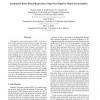CVPR
2010
IEEE
14 years 4 months ago
2010
IEEE
The camera in video conference systems is typically positioned above, or below, the screen, causing the gaze of the users to appear misplaced. We propose an effective solution to ...
CVPR
2010
IEEE
14 years 4 months ago
2010
IEEE
In this paper, a new scheme to address the face recognition problem is proposed. Different from traditional face recognition approaches which represent each facial image by a sing...
CVPR
2010
IEEE
14 years 4 months ago
2010
IEEE
Given a set of 2D images, we propose a novel approach for the reconstruction of straight 3D line segments that represent the underlying geometry of static 3D objects in the scene....
CVPR
2010
IEEE
14 years 4 months ago
2010
IEEE
Long-term persistent tracking in ever-changing environments is a challenging task, which often requires addressing difficult object appearance update problems. To solve them, most...
CVPR
2010
IEEE
14 years 4 months ago
2010
IEEE
Non-negative matrix factorization (NMF) is an excellent tool for unsupervised parts-based learning, but proves to be ineffective when parts of a whole follow a specific pattern. ...
CVPR
2010
IEEE
14 years 4 months ago
2010
IEEE
Finding fiducial facial points in any frame of a video showing rich naturalistic facial behaviour is an unsolved problem. Yet this is a crucial step for geometric-featurebased fa...
CVPR
2010
IEEE
14 years 4 months ago
2010
IEEE
This paper proposes a new learning method, which integrates feature selection with classifier construction for human detection via solving three optimization models. Firstly, the ...
CVPR
2010
IEEE
14 years 4 months ago
2010
IEEE
Treating visual object tracking as foreground and background classification problem has attracted much attention in the past decade. Most methods adopt mean shift or brute force s...
CVPR
2010
IEEE
14 years 4 months ago
2010
IEEE
Real-world face recognition systems often have to face the single sample per person (SSPP) problem, that is, only a single training sample for each person is enrolled in the datab...
CVPR
2010
IEEE
14 years 4 months ago
2010
IEEE
This paper presents a video resizing approach that provides both efficiency and temporal coherence. Prior approaches either sacrifice temporal coherence (resulting in jitter), o...

